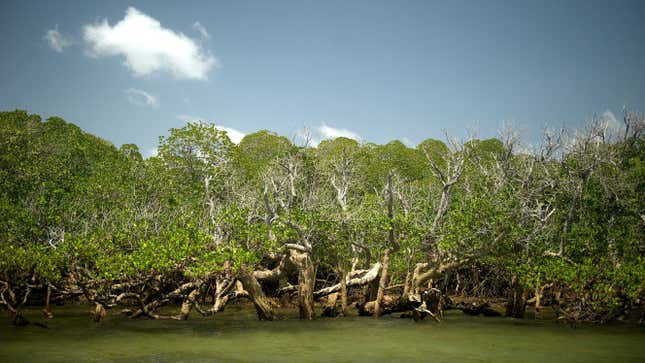
Mangrove forests are ecological wonders that house thousands of species and protect coastline communities from storm surge. Plus, just look at them. They’re beautiful.
But according to a study published in Science on Thursday, if we don’t curb our greenhouse gas emissions, rising seas could drown them by 2050. That would cause an ecological disaster and endanger coastal communities.
Mangrove ecosystems can adapt to some level of sea level rise by building up sediment and migrating inland. But those defenses are only effective if sea levels aren’t pushed up too quickly. Past a certain point, the forests can’t keep up. The authors wanted to determine what that point is, so they looked to ancient history.
Due to different rates glaciers melting over the past 10,000 years, the pace of sea level rise has varied widely, from more than 0.4 inches (10 millimeters) per year to reaching nearly stable conditions 4,000 years later. By analyzing sediment data from 78 mangrove ecosystems from the past ten millennia, the team determined that mangroves are more likely to die out when sea level rise rates exceed 0.23 inches (6 millimeters). The problem is, if world leaders do nothing to curb greenhouse gas emissions (a scenario known as RCP8.5), scientists expect we’ll exceed 0.28 inches (0.7 millimeters) per year by 2050.
If that happens, the consequences will be massive. Mangrove ecosystems—which are found on the Atlantic coast from Florida to Argentina, on Africa’s coasts, and in other warm climates—store even more carbon than rainforests. Losing them would wreak havoc on the climate. Partially submerged, partially above water, mangrove forests are also among the richest sources of biodiversity on the planet by providing habitat for a variety of terrestrial, aquatic, and aerial creatures.
“If they disappear, there’s going to be imbalances in the number of fish and other species that rely on them,” co-author Erica Ashe, a postdoctoral scientist at Rutgers University, told Earther. “And that could have effects on other species, even ones that actually aren’t sheltered by these mangroves, because when the levels of different species change, that can affect the entire system.”
That system includes people. Fishermen, for instance, depend on species that live in the ecosystems for their livelihoods. And according to separate study published in PLOS One last week, the ecosystems are also currently providing a buffer between rising seas and storm surges that at least protect 5.3 million people.
“It’s critical that we reduce sea level rise itself to reduce these impacts to people and to ensure that mangroves themselves can continue to flourish, protect people, and absorb large amounts of carbon,” Will Turner, a co-author of the PLOS One study and senior vice president of Conservation International, told Earther.
The world still has time to preserve the forests. If we lower carbon emissions, the annual rate of sea level rise is still expected to stay under 0.2 inches (5 millimeters) throughout the 21st century. At the same time, leaders can take action to protect mangrove forests from other threats, like coastal development projects.
“We know that the highest priority is stopping sea level rise and climate change itself,” said Turner. “What we also understand is that protecting mangroves now and in the future is a no-regrets benefit to people.”